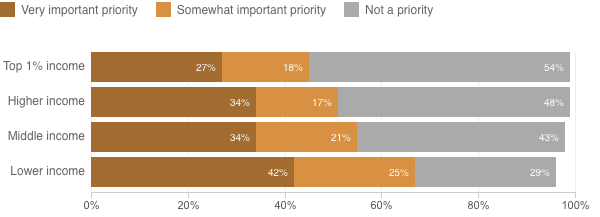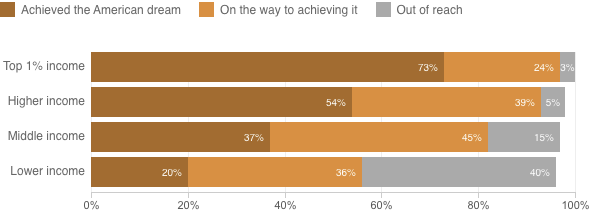Is There Hope For The American Dream? What Americans Think About Income Inequality
January 9, 2020 - NPR
Joe Neel
Income inequality in the U.S. is at an
all-time high, according to the Census Bureau. But do Americans care?
A new
poll from NPR, the Robert Wood Johnson Foundation and the Harvard T.H. Chan
School of Public Health shows that less than half of Americans, regardless of
income, view it as very serious problem.
They hold these views even though a majority (57%) believes very wealthy
Americans should pay more in taxes than they do now. Nearly half (48%) of the
top 1% believe very wealthy Americans should pay more.
The poll, which surveyed 1,885 adults, is unique in that it was designed to
reach a sample of at least 250 people in the upper 1% of income — $500,000 or
more of household income a year. That opens a window on the views and
experiences of this exclusive group that polls have not been able to capture.
In the future, should it be a priority for the president and
Congress to reduce income differences between people with high incomes
and those with low incomes?

Notes
Lower-income adults live in households earning less than $35,000/year;
middle-income adults' household earnings are $35,000-$99,999/year; higher-income
adults' household earnings are $100,000-$499,999/year; and top 1% income adults'
household earnings are at least $500,000/year.
Source: NPR/Robert Wood Johnson Foundation/Harvard T.H. Chan School of Public
Health poll: "Life Experiences and Income Inequality in the United States." The
survey of 1,885 adults was conducted July 17-Aug. 18. The margin of error is 3.2
percentage points. "Don't know/refused" answers not shown.
Credit: Alyson Hurt/NPR
A sizable minority of the wealthiest Americans (45%) say reducing income
inequality should be a priority for political leaders, though support for this
idea was significantly higher among the poorest Americans (67%).
Achieving the American Dream
There were a few surprises in the poll. While the vast majority of the top 1%
say they've achieved the American Dream, similar majorities of low- and
middle-income people believe the American Dream is still within reach.
Views On Achieving The American Dream

Notes
Lower-income adults live in households earning less than $35,000/year;
middle-income adults' household earnings are $35,000-$99,999/year; higher-income
adults' household earnings are $100,000-$499,999/year; and top 1% income adults'
household earnings are at least $500,000/year.
Source: NPR/Robert Wood Johnson Foundation/Harvard T.H. Chan School of Public
Health poll: "Life Experiences and Income Inequality in the United States." The
survey of 1,885 adults was conducted July 17-Aug. 18. The margin of error is 3.2
percentage points.
Credit: Alyson Hurt/NPR
In addition, 70% to 80% of parents and grandparents across income groups
believe their children or grandchildren will achieve the American Dream. (We did
not provide a definition for American Dream in our questions – so the responses
reflect whatever people think it is.)
What it takes to be successful
There was remarkable agreement among the income groups that hard work is seen
as very important in being economically successful in America today. That's
despite research showing that factors such as family income, neighborhood and
race/ethnicity are closely tied to economic achievement.
The top 1% and middle- and lower-income adults did not see those factors as
being very important to economic success.
For each of the following, please tell me how important you think it is for
being economically successful in America today.
|
|
|
|
|
|
| Hard work |
87% |
89% |
90% |
93% |
| Coming from an upper-income
family |
37% |
37% |
29% |
33% |
| Growing up in an upper-income
neighborhood |
37% |
30% |
29% |
34% |
| A person's racial/ethnic
background |
33% |
24% |
26% |
27% |
Even though there's a good deal of optimism about future generations' ability
to achieve economic success, about half of adults across income groups say it is
harder for the average person to earn a middle-class income today, compared with
when they were children.
Compared to when you were a child, do you think itfs harder or easier in the
United States today for the average person to earn a middle-class
income, or is it about the same?

Notes
Lower-income adults live in households earning less than $35,000/year;
middle-income adults' household earnings are $35,000-$99,999/year; higher-income
adults' household earnings are $100,000-$499,999/year; and top 1% income adults'
household earnings are at least $500,000/year.
Source: NPR/Robert Wood Johnson Foundation/Harvard T.H. Chan School of Public
Health poll: "Life Experiences and Income Inequality in the United States." The
survey of 1,885 adults was conducted July 17-Aug. 18. The margin of error is 3.2
percentage points. "Don't know/refused" answers not shown.
Credit: Alyson Hurt/NPR
Health and education
A majority across all income groups says it is an important priority for
government to make sure everyone living in the U.S. has health insurance
coverage.
In the future, should it be a priority for the president and Congress to
make sure everyone living in the United States has health insurance coverage?

Notes
Lower-income adults live in households earning less than $35,000/year;
middle-income adults' household earnings are $35,000-$99,999/year; higher-income
adults' household earnings are $100,000-$499,999/year; and top 1% income adults'
household earnings are at least $500,000/year.




